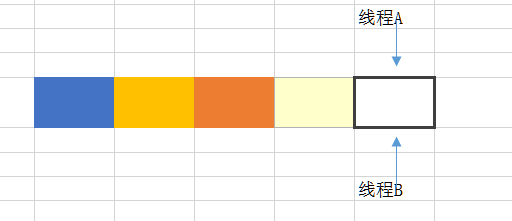HashMap執行緒不安全的表現 -- Java 8
HashMap執行緒不安全的表現 -- Java 8
先來看看HashMap.put方法的原始碼
public V put(K key, V value) {
return putVal(hash(key), key, value, false, true);
}
final V putVal(int hash, K key, V value, boolean onlyIfAbsent,
boolean evict) {
Node<K,V>[] tab; Node<K,V> p; int n, i;
if ((tab = table) == null || (n = tab.length) == 0)
n = (tab = resize()).length;
if ((p = tab[i = (n - 1) & hash]) == null) //如果該位置為null,說明沒有雜湊衝突,直接插入 --------------------(1)
tab[i] = newNode(hash, key, value, null);
else {
Node<K,V> e; K k;
if (p.hash == hash &&
((k = p.key) == key || (key != null && key.equals(k))))
e = p;
else if (p instanceof TreeNode)
e = ((TreeNode<K,V>)p).putTreeVal(this, tab, hash, key, value);
else {
for (int binCount = 0; ; ++binCount) {
if ((e = p.next) == null) {
p.next = newNode(hash, key, value, null);
if (binCount >= TREEIFY_THRESHOLD - 1) // -1 for 1st
treeifyBin(tab, hash);
break;
}
if (e.hash == hash &&
((k = e.key) == key || (key != null && key.equals(k))))
break;
p = e;
}
}
if (e != null) { // existing mapping for key
V oldValue = e.value;
if (!onlyIfAbsent || oldValue == null)
e.value = value;
afterNodeAccess(e);
return oldValue;
}
}
++modCount;
if (++size > threshold)
resize();
afterNodeInsertion(evict);
return null;
}如果有兩個執行緒A和B,都進行插入資料,剛好這兩條不同的資料經過雜湊計算後得到的雜湊碼是一樣的,且該位置還沒有其他的資料。所以這兩個執行緒都會進入我在上面標記為1的程式碼中。假設一種情況,執行緒A通過if判斷,該位置沒有雜湊衝突,進入了if語句,還沒有進行資料插入,這時候CPU就把資源讓給了執行緒B,執行緒A停在了if語句裡面,執行緒B判斷該位置沒有雜湊衝突(執行緒A的資料還沒插入),也進入了if語句,執行緒B執行完後,輪到執行緒A執行,現線上程A直接在該位置插入而不用再判斷。這時候,你會發現執行緒A把執行緒B插入的資料給覆蓋了。發生了執行緒不安全情況。本來在HashMap中,發生雜湊衝突是可以用連結串列法或者紅黑樹來解決的,但是在多執行緒中,可能就直接給覆蓋了。
上面所說的是一個圖來解釋可能更加直觀。如下面所示,兩個執行緒在同一個位置新增資料,後面新增的資料就覆蓋住了前面新增的。

發生在連結串列處插入資料發生執行緒不安全的情況也相似。

如兩個執行緒都在遍歷到最後一個節點,都要在最後新增一個數據,那麼後面新增資料的執行緒就會把前面新增的資料給覆蓋住。
我能想到的其他情況:在擴容的時候插入資料,有可能會把新插入的覆蓋住;在擴容的時候刪除資料,會刪除不了。
下面是擴容方法resize()的部分程式碼
如果我在擴容時,在資料從舊陣列複製到新陣列過程中,這時候某個執行緒插入一條資料,這時候是插入到新陣列中,但是在資料複製過程中,HashMap是沒有檢查新陣列上的位置是否為空,所以新插入的資料會被後面從舊陣列中複製過來的資料覆蓋住。
如果在(2)剛執行後,某個執行緒就立刻想刪除以前插入的某個元素,你會發現刪除不了,因為table指向了新陣列,而這時候新陣列還沒有資料。
1 Node<K,V>[] newTab = (Node<K,V>[])new Node[newCap];//----------------------(1)
2 table = newTab;// ------------------------(2)
3 if (oldTab != null) {
4 for (int j = 0; j < oldCap; ++j) {
5 Node<K,V> e;
6 if ((e = oldTab[j]) != null) {
7 oldTab[j] = null;
8 if (e.next == null)
9 newTab[e.hash & (newCap - 1)] = e; //---------------在新陣列上插入陣列都不會檢查該位置是否為null
10 else if (e instanceof TreeNode)
11 ((TreeNode<K,V>)e).split(this, newTab, j, oldCap);
12 else { // preserve order
13 Node<K,V> loHead = null, loTail = null;
14 Node<K,V> hiHead = null, hiTail = null;
15 Node<K,V> next;
16 do {
17 next = e.next;
18 if ((e.hash & oldCap) == 0) {
19 if (loTail == null)
20 loHead = e;
21 else
22 loTail.next = e;
23 loTail = e;
24 }
25 else {
26 if (hiTail == null)
27 hiHead = e;
28 else
29 hiTail.next = e;
30 hiTail = e;
31 }
32 } while ((e = next) != null);
33 if (loTail != null) {
34 loTail.next = null;
35 newTab[j] = loHead; //-------------------在新陣列上插入陣列都不會檢查該位置是否為null
36 }
37 if (hiTail != null) {
38 hiTail.next = null;
39 newTab[j + oldCap] = hiHead; //------------在新陣列上插入陣列都不會檢查該位置是否為null
40 }
41 }
42 }
43 }
44 }

